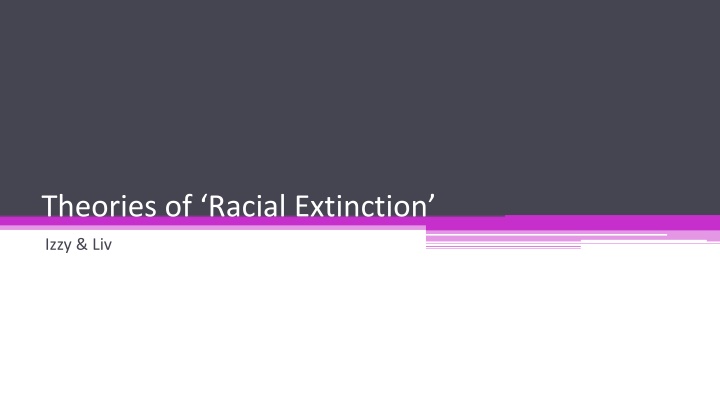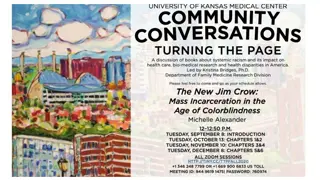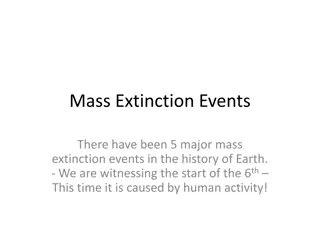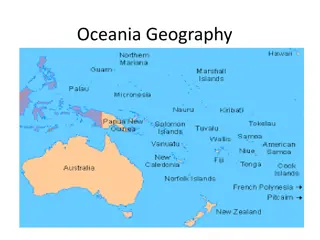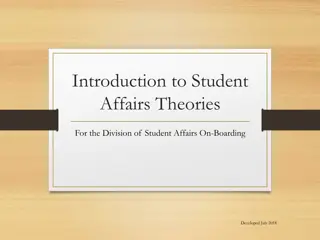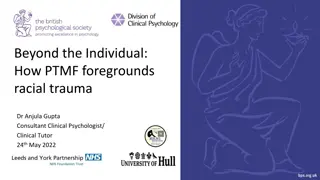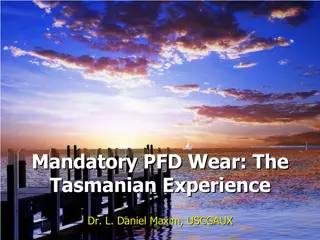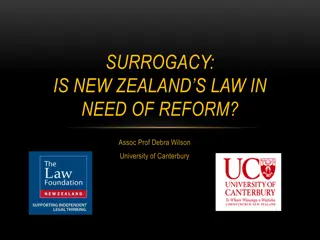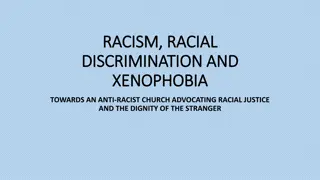Theories of Racial Extinction in Colonial Tasmania and New Zealand
The colonial period saw the Tasmanian Aboriginals and Māori labeled as doomed races, facing extinction due to European settlement and scientific racism. Pseudoscience, craniometry, and social Darwinism justified their marginalization and dispossession, portraying them as relics of a bygone era. Despite resistance, both populations suffered immense population decline, culminating in symbolic extinctions. The legacy of these ideas continues to shape perceptions of indigenous peoples.
Download Presentation

Please find below an Image/Link to download the presentation.
The content on the website is provided AS IS for your information and personal use only. It may not be sold, licensed, or shared on other websites without obtaining consent from the author.If you encounter any issues during the download, it is possible that the publisher has removed the file from their server.
You are allowed to download the files provided on this website for personal or commercial use, subject to the condition that they are used lawfully. All files are the property of their respective owners.
The content on the website is provided AS IS for your information and personal use only. It may not be sold, licensed, or shared on other websites without obtaining consent from the author.
E N D
Presentation Transcript
Theories of Racial Extinction Izzy & Liv
John J. Cove, What the Bones Say: Tasmanian Aborigines, Science, and Domination (Ottawa, 1995), 'Ch. 2: The Early Colonial Period (1803-1876)', pp. 19-58 1. Before colonisation, the Tasmanian Aboriginals were semi-nomadic hunters and the M ori were horticulturalists with strong tribal structures. The Europeans dismissed their societies as primitive . 2. The British soon imposed colonial policies upon these regions. Expansion led to violence, such as Tasmania s Black Line a failed military campaign to confine the indigenous peoples, whilst assimilation policies such as M ori missionary schooling stripped indigenous peoples of their autonomy and agency. 3. These colonial policies were deeply informed by pseudoscience and scientific racism. Craniometry studies likened Aboriginal Tasmanians to animals or missing links . M ori were framed as doomed to extinction which was justified by settlers who romanticised their decline as part of a natural order. 4. Despite oppression, the Tasmanians resisted colonial pressure through direct confrontation but were overwhelmed by disease and colonial violence. The M ori organised movements like K ngitanga to protect land and sovereignty and were able to adapt to colonial pressures both legally and politically. 5. The colonial period meant both populations suffered huge population decline. In Tasmania, the death of King Billy marked the symbolic extinction of the Parlevar. ( ) the death of the last Tasmanian Aborigine in 1876 was tragic but unavoidable. If there was anything positive for Europeans about her death and the belief that the entire population was extinct, it was the ending of an Aboriginal problem in Tasmania. p. 45.
Russell McGregor, 'The Doomed Race: A Scientific Axiom of the Late Nineteenth Century', Australian Journal of Politics and History 39 (1993), 14-22. 1. M ori and Aboriginal populations were widely considered doomed races during the late 19th early 20th centuries. Social Darwinism legitimised European settlement and progress in New Zealand and in Australia, Aboriginal extinction was framed as axiomatic and natives depicted as living fossils , doomed to disappear under the pressures of modernity. In both contexts, indigenous peoples were placed at the bottom of racial hierarchies whilst being romanticised as noble savages. Indigenous people were valuable only as subjects to serve anthropological enquiries and pseudo scientific practices before their inevitable demise. Indigenous displacement was portrayed as a natural and even benevolent process, which served colonial agendas. Native Schools were installed in M ori communities, yet curriculums were centred on the English language. Figures like James Pope argued indigenous survival depended on adopting European morality and sanitation. There was scientific debate that questioned the empirical basis of extinction claims. For example, the M ori population stabilisation in the late nineteenth century contradicted predictions of inevitable decline. The idea of the doomed race had long term consequences. It shaped public belief of indigenous peoples as relics of a bygone era, justifying dispossession. It also reinforced racial hierarchies and legitimised European colonialism. 2. European attitudes and actions towards Aborigines ( ) can be understood only in the context of a firm conviction that they had not long to live. p. 18. 3. 4. 5.
Raeburn Lange, May the People Live: A History of Maori Health Development, 1900- 1920 (Auckland, 1999), 'Chapter 3: Tales of a Dying Race,' pp. 53-83. 1. Throughout the nineteenth century, it was widely believed by European settlers that the M ori population was doomed to extinction. Their inevitable decline was rationalised through pseudo-scientific ideas theories like natural displacement likened the M ori extinction to the replacement of native flora & fauna by the stronger European race. Some Europeans saw their role amongst the M ori as a form of benevolent trusteeship . M ori were often regarded as noble savages who, in order to be saved, needed assimilating to European custom and culture. However, this paternalism was deeply ethnocentric and dismissed indigenous culture, with M ori health and welfare subordinated to the broader colonial agenda. By the late nineteenth century, government efforts began to address M ori health by implementing native medical officers and practical initiatives, such as vaccination campaigns, but these were generally underfunded and ad hoc. M ori leaders and communities were passionate about preserving their culture and withstanding their agency. Groups like the Te Aute College Association advocated for self- determination and practical health measures against the Europeans. By the early twentieth century, the inevitable M ori extinction narrative came to a halt as indigenous populations stablished and showed signs of recovery. 2. If there was any hope for a future for the Maori, it was that their blood might be perpetuated as a trace in a future strain of the blended New Zealander. p. 56. 3. 4. 5.
Richard Weikart, 'Progress through Racial Extermination: Social Darwinism, Eugenics, and Pacifism in Germany, 1860-1918', German Studies Review, 26 (2003), pp. 273- 294. 1. During the 19th century, there was a rise of theories explaining the demographic decline of indigenous peoples. Darwinists of the period like Haeckel believed that inherent biological and racial inequality, rather than colonial activities, explained population decline. 2. Settlers and colonial powers employed biological and evolutionary arguments to rationalize their actions. German colonisers justified their actions by seeing their conquest of the Hereros as a racial struggle where only one group can succeed. Oftentimes, imperial powers framed indigenous populations as inherently doomed to extinction due to their supposed inability to adapt to the demands of modern civilization. 3. Some eugenicists were also pacifists, but they saw pacifism as a way to facilitate European domination of other races. 4. German colonist propaganda differed to its British counterpart, rather than invoking religious and humanitarian rhetoric, they relied on social Darwinist and biological racist arguments. 5. The legacy of racial extermination is identifiable in the views of individuals like Hitler. These rhetorics influenced policies and ideologies well into the 20th century. Haeckel argued that since the Australian aborigines psyche is closer to apes and dogs than to Europeans, their lives do not have the same value as Europeans p. 282.
Sadiah Qureshi, Dying Americans: Race, Extinction, and Conservation in the New World, in Astrid Swenson and Peter Mandler (eds.), From Plunder to Preservation: Britain and the Heritage of Empire, c.1800-1940 (Oxford, 2013). 1. In the 19th century, extinction was increasingly seen as an endemic and natural process, supported by scientific advancements such as the work of Georges Cuvier on fossils. Instead of recognising the impact of genocidal practices, extinction was increasingly seen as an inevitable outcome of colonisation and 'intercultural contact.' 2. Settlers used extinction theories to support the removal of Indigenous peoples from ancestral lands. They argued that protecting Indigenous peoples required relocating them to reservations, allowing for settler expansion and the establishment of national parks. 3. Indigenous people were increasingly seen as relics of the past, justifying their removal and denying them continued use of and management of their ancestral lands. The United States government created national parks to exclude American Indians. 4. The Indian Removal Act of 1830 forcibly removed American Indians from their land, policies developed to confine them to reservations, and later allotment systems under the Dawes Act of 1887. 5. Conservationist efforts framed indigenous people as threats to the environment, erasing their contributions to maintaining land prior to colonisation. Qureshi concludes by emphasising the importance of reconciling environmental goals with justice for displaced communities It has been suggested that the reservation system was modelled on the use of asylums in broader contexts to isolate problematic individuals in special environments in order to correct perceived shortcomings. p. 276.
1. To what extent were indigenous resistance movements effective in countering narrative of inevitable extinction and preserving cultural agency during colonial expansion? 2. How did racial theory shape colonial policies towards indigenous populations in the 19th and 20th centuries?
